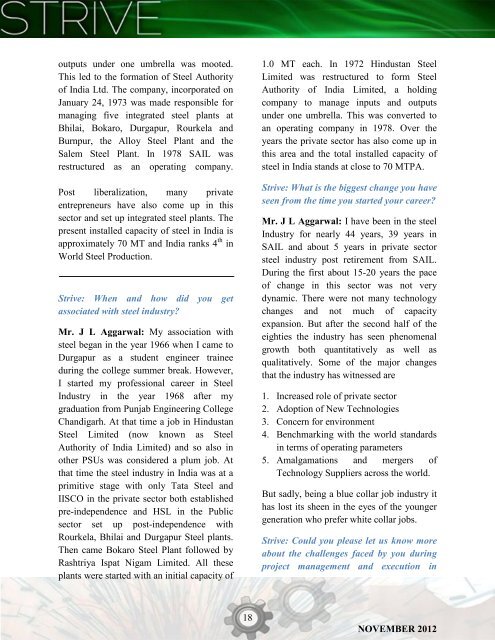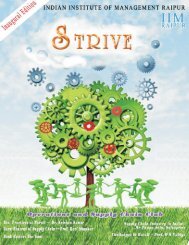sTRIVE final.pdf
Create successful ePaper yourself
Turn your PDF publications into a flip-book with our unique Google optimized e-Paper software.
outputs under one umbrella was mooted.<br />
This led to the formation of Steel Authority<br />
of India Ltd. The company, incorporated on<br />
January 24, 1973 was made responsible for<br />
managing five integrated steel plants at<br />
Bhilai, Bokaro, Durgapur, Rourkela and<br />
Burnpur, the Alloy Steel Plant and the<br />
Salem Steel Plant. In 1978 SAIL was<br />
restructured as an operating company.<br />
Post liberalization, many private<br />
entrepreneurs have also come up in this<br />
sector and set up integrated steel plants. The<br />
present installed capacity of steel in India is<br />
approximately 70 MT and India ranks 4 th in<br />
World Steel Production.<br />
Strive: When and how did you get<br />
associated with steel industry?<br />
Mr. J L Aggarwal: My association with<br />
steel began in the year 1966 when I came to<br />
Durgapur as a student engineer trainee<br />
during the college summer break. However,<br />
I started my professional career in Steel<br />
Industry in the year 1968 after my<br />
graduation from Punjab Engineering College<br />
Chandigarh. At that time a job in Hindustan<br />
Steel Limited (now known as Steel<br />
Authority of India Limited) and so also in<br />
other PSUs was considered a plum job. At<br />
that time the steel industry in India was at a<br />
primitive stage with only Tata Steel and<br />
IISCO in the private sector both established<br />
pre-independence and HSL in the Public<br />
sector set up post-independence with<br />
Rourkela, Bhilai and Durgapur Steel plants.<br />
Then came Bokaro Steel Plant followed by<br />
Rashtriya Ispat Nigam Limited. All these<br />
plants were started with an initial capacity of<br />
1.0 MT each. In 1972 Hindustan Steel<br />
Limited was restructured to form Steel<br />
Authority of India Limited, a holding<br />
company to manage inputs and outputs<br />
under one umbrella. This was converted to<br />
an operating company in 1978. Over the<br />
years the private sector has also come up in<br />
this area and the total installed capacity of<br />
steel in India stands at close to 70 MTPA.<br />
Strive: What is the biggest change you have<br />
seen from the time you started your career?<br />
Mr. J L Aggarwal: I have been in the steel<br />
Industry for nearly 44 years, 39 years in<br />
SAIL and about 5 years in private sector<br />
steel industry post retirement from SAIL.<br />
During the first about 15-20 years the pace<br />
of change in this sector was not very<br />
dynamic. There were not many technology<br />
changes and not much of capacity<br />
expansion. But after the second half of the<br />
eighties the industry has seen phenomenal<br />
growth both quantitatively as well as<br />
qualitatively. Some of the major changes<br />
that the industry has witnessed are<br />
1. Increased role of private sector<br />
2. Adoption of New Technologies<br />
3. Concern for environment<br />
4. Benchmarking with the world standards<br />
in terms of operating parameters<br />
5. Amalgamations and mergers of<br />
Technology Suppliers across the world.<br />
But sadly, being a blue collar job industry it<br />
has lost its sheen in the eyes of the younger<br />
generation who prefer white collar jobs.<br />
Strive: Could you please let us know more<br />
about the challenges faced by you during<br />
project management and execution in<br />
18<br />
NOVEMBER 2012







